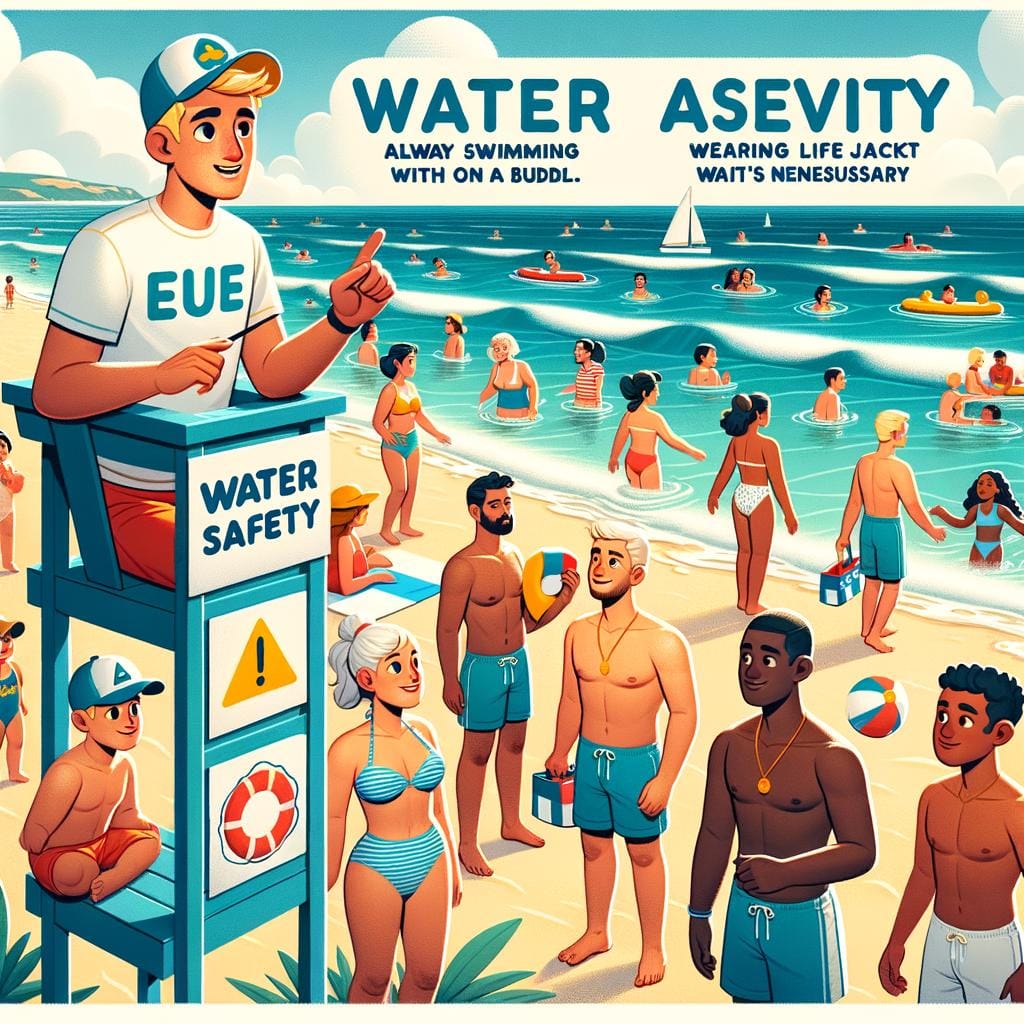Water safety is a crucial aspect of enjoying aquatic activities and ensuring the well-being of oneself and others. Whether it is swimming in a pool, relaxing at the beach, or exploring lakes and rivers, understanding the risks and best practices can help prevent accidents and promote a safe experience for all. In this article, we will delve into the significance of water safety and provide valuable insights on how to stay safe in various aquatic settings.
One of the most important aspects of water safety is being aware of potential hazards like drowning and waterborne illnesses. By understanding these risks and taking necessary precautions, individuals can reduce the likelihood of accidents occurring. Factors such as weather conditions, water currents, and supervision play a crucial role in ensuring the safety of swimmers, highlighting the importance of being mindful of these elements when in or near water bodies.
From essential water safety tips for children to measures adults can take to be prepared for emergencies, this comprehensive guide will cover a range of topics aimed at promoting awareness and education on staying safe in different aquatic environments. By observing proper safety protocols, being equipped with necessary skills like CPR training, rescue techniques, and carrying first aid kits, individuals can enjoy their time in the water while minimizing risks and enhancing their overall well-being.
Common Water Safety Hazards
Drowning is one of the most common water safety hazards that can occur in any body of water, from swimming pools to natural bodies of water. It is essential for both children and adults to be aware of the risks associated with drowning and take necessary precautions to prevent it.
Supervision is key when it comes to preventing drowning incidents, especially when young children or inexperienced swimmers are involved. In addition to supervision, learning how to swim and practicing proper water safety skills can greatly reduce the risk of drowning.
Another significant water safety hazard is the risk of waterborne illnesses, which are caused by pathogens present in contaminated water sources. These illnesses can range from minor infections to more severe conditions like gastrointestinal diseases.
It’s crucial for individuals engaging in water activities to be mindful of the quality of the water they are exposed to and take necessary precautions. This includes avoiding swallowing pool or lake water, taking regular breaks from swimming, and showering after being in a natural body of water.
In addition to drowning and waterborne illnesses, other common water safety hazards include diving accidents, sunburns from prolonged sun exposure, and injuries caused by rough waters or underwater obstructions. By being informed about these potential risks and following proper safety guidelines, individuals can enjoy their time in the water while minimizing the chances of accidents or injuries.
Maintaining awareness of these hazards and staying knowledgeable about best practices for water safety are essential steps towards promoting a safe aquatic experience for everyone involved.
| Water Safety Hazard | Precautionary Measures |
|---|---|
| Drowning | Supervision, swimming lessons, life jackets |
| Waterborne Illnesses | Avoid swallowing pool/lake water, take regular breaks |
| Diving Accidents | Check for depth markers before diving |
Factors Affecting Water Safety
When it comes to water safety, various factors come into play that can greatly impact the risks involved in any aquatic activity. Weather conditions play a significant role in determining the safety of individuals in the water.
Strong winds, thunderstorms, or extreme heat can all pose serious threats to swimmers and boaters alike. It is essential to check weather forecasts before heading out for any water-related activities and to be aware of any potential changes in weather patterns while you are already out on the water.
Another crucial factor affecting water safety is water currents. Whether you are swimming in the ocean, a river, or a lake, currents can be unpredictable and strong, posing a risk to even experienced swimmers. It is important to understand how these currents work and how they may affect your ability to stay safe in the water. Being knowledgeable about rip currents, undertows, and tidal currents can help you make informed decisions about when and where it is safe to swim.
Supervision is yet another vital factor that plays a critical role in ensuring water safety, especially for children. Lack of supervision around water bodies can lead to tragic accidents such as drowning. It is crucial for parents, guardians, or responsible adults to actively watch over children when they are near or in the water. By providing constant supervision and being alert to any potential dangers, adults can prevent many water-related incidents from occurring.
| Factor | Impact |
|---|---|
| Weather Conditions | Strong winds, thunderstorms, or extreme heat pose risks |
| Water Currents | Unpredictable currents like rip currents can endanger swimmers |
| Supervision | Lack of adult supervision increases risk of drowning incidents |
Essential Water Safety Tips for Children
Water safety is crucial when it comes to children, as they are particularly vulnerable around water bodies. Implementing essential water safety tips for children can significantly reduce the risks associated with drowning and other water-related accidents. Here are some key tips to ensure the safety of children in aquatic environments:
- Enroll your child in swimming lessons: Teaching children how to swim not only boosts their confidence in the water but also equips them with lifesaving skills. Swimming lessons help children understand basic water safety rules and techniques, such as floating and treading water.
- Ensure the use of life jackets: Life jackets are essential for children who are still learning how to swim or are not strong swimmers. Always make sure that your child wears a properly fitted life jacket when near any body of water, whether it be a pool, beach, lake, or river.
- Provide adult supervision at all times: It is crucial to have responsible adult supervision whenever children are around water. Adults should actively watch over children while they are swimming or playing in the water to prevent any accidents from occurring.
By adhering to these important water safety tips for children, parents and guardians can help create a safer environment for their little ones. With proper guidance and precautions in place, the risk of drowning incidents can be significantly minimized. Remember, vigilance and education are key components in promoting water safety awareness among children.
Water Safety Measures for Adults
Water safety is a critical concern for individuals of all ages, including adults. While many water-related incidents involve children, adults are also at risk of accidents and emergencies while in or near bodies of water. Therefore, it is essential for adults to be well-prepared and knowledgeable about water safety measures to ensure their own safety as well as that of others.
Importance of CPR Training
One of the most crucial skills that adults can acquire to enhance water safety is CPR training. Cardiopulmonary resuscitation (CPR) is a lifesaving technique that can be used in emergency situations where an individual’s breathing or heartbeat has stopped. By learning how to perform CPR properly, adults can significantly increase the chances of survival for someone experiencing a drowning or other water-related incident.
Rescue Techniques
In addition to CPR training, understanding basic rescue techniques can also play a vital role in ensuring water safety for adults. Knowing how to rescue someone who is in distress in the water without putting oneself at risk is essential. Adults should learn how to safely assist others in trouble, whether it involves using floatation devices, reaching out with a rescue pole, or calling for professional help when needed.
Importance of First Aid Kits
Another important aspect of water safety for adults is having access to first aid kits at all times when engaging in activities near water. First aid kits should contain essentials such as bandages, antiseptic wipes, gauze pads, and adhesive tape to address minor injuries or provide immediate care before professional medical assistance arrives. Being prepared with a well-stocked first aid kit can make a significant difference in responding effectively to unexpected incidents by the water.
By prioritizing CPR training, learning rescue techniques, and carrying first aid kits, adult individuals can contribute to promoting water safety not only for themselves but also for their families and communities. These proactive measures are integral components of staying safe while enjoying various aquatic activities throughout different settings such as pools, beaches, lakes, and rivers. Remembering these crucial aspects of adult water safety can help prevent tragedies and promote an enjoyable and secure experience by the water’s edge.
Water Safety in Different Settings
When it comes to water safety, being aware of the potential hazards in different settings such as pools, beaches, lakes, and rivers is crucial. Each environment presents unique challenges that individuals need to be mindful of to ensure their safety while enjoying aquatic activities. Understanding the specific risks associated with these different settings can help prevent accidents and emergencies.
Pools are a common setting for recreational swimming and should always be equipped with proper safety measures such as fences, lifeguards, and warning signs. Drowning is a significant concern in pools, especially for young children, so close adult supervision is essential. Additionally, individuals should be cautious of slippery pool decks and follow posted rules for diving to avoid head injuries.
Beaches offer a variety of water activities but can also pose dangers like strong currents and rip tides. It’s crucial to swim near lifeguard towers and pay attention to warning flags indicating water conditions. Always enter the water feet first if unsure of the depth and avoid swimming alone or after consuming alcohol. Knowing how to identify rip currents and escape them safely can make a significant difference in avoiding potential tragedies.
Lakes and rivers provide opportunities for boating, fishing, and kayaking but come with their own set of risks such as changing water levels and unpredictable currents. It’s important to wear properly fitted life jackets while engaging in water activities on lakes or rivers.
Individuals should also familiarize themselves with the area’s water conditions before venturing out and have basic knowledge of rescue techniques or CPR in case of emergencies. Being prepared and informed about water safety measures can ensure a fun and safe experience in any aquatic setting.
Understanding Rip Currents and How to Stay Safe
Rip currents are powerful, narrow channels of fast-moving water that can pull swimmers away from the shore. These currents can be difficult to spot, even for experienced swimmers, making them a significant water safety hazard. Understanding how rip currents form and knowing how to stay safe when encountering them is crucial for anyone planning to swim in the ocean.
How Rip Currents Form
Rip currents typically form when water piles up near the shore due to incoming waves and then flows back towards deeper waters through a narrow channel. This rapid flow of water creates a strong current that can catch unsuspecting swimmers off guard. In many cases, rip currents are strongest near jetties, piers, and sandbars where the underwater topography funnels the water in a concentrated stream.
Staying Safe in Rip Currents
If you find yourself caught in a rip current, it’s important not to panic. The most crucial thing to remember is not to try to swim against the current directly back to shore. Instead, swim parallel to the shoreline until you are out of the grip of the rip current.
Once you no longer feel like you’re being pulled seaward, you can then attempt to swim back to land or tread water while signaling for help if needed. It’s also essential to remain calm and conserve your energy while waiting for assistance.
Overall, awareness of rip currents and how they behave is key in ensuring your safety when enjoying the ocean. By educating yourself on proper safety measures and understanding how to respond if caught in one, you can significantly reduce the risks associated with these powerful natural phenomena. Remembering these precautions can help make your beach outings both enjoyable and safe, promoting overall water safety for everyone involved.
Importance of Life Jackets and Proper Use
Life jackets are a crucial element of water safety, especially when it comes to preventing drowning incidents. Whether swimming in pools, lakes, rivers, or the ocean, wearing a properly fitted life jacket can make all the difference in a potential emergency situation.
Life jackets provide buoyancy and help individuals stay afloat if they unexpectedly fall into the water or encounter rough currents. This is particularly important for children and inexperienced swimmers who may not have the strength or skills to swim to safety.
It is essential to not only have a life jacket but also ensure that it is being used correctly. Proper usage includes fastening all straps and buckles securely, ensuring a snug fit without being too tight or restrictive.
Before engaging in any water activities, it is crucial to check the condition of the life jacket for any damages or defects that may affect its functionality. Additionally, it is recommended to choose an appropriate life jacket based on the individual’s size, weight, and intended water activity.
In situations where boating or water sports are involved, wearing a life jacket becomes even more critical due to the increased risk of accidents or sudden immersion in deep water. Even strong swimmers can benefit from wearing a life jacket as unexpected circumstances can quickly turn dangerous without warning.
By prioritizing the use of life jackets and adhering to proper guidelines for their usage, individuals can significantly reduce the risk of drowning and enhance overall water safety awareness for themselves and others.
Conclusion
In conclusion, promoting water safety awareness is crucial for ensuring a safer summer for everyone. Whether it’s enjoying a day at the pool, beach, lake, or river, being knowledgeable about potential hazards and taking necessary precautions can prevent accidents and tragedies. By understanding the importance of water safety and implementing essential tips and measures, individuals can enjoy aquatic activities while minimizing risks.
One of the key factors in maintaining water safety is proper supervision, especially when it comes to children. Enrolling kids in swimming lessons, ensuring they wear life jackets in open water, and having adult supervision at all times are vital practices. Additionally, adults should also be prepared with CPR training, rescue techniques, and first aid kits in case of emergencies. By equipping oneself with these skills and knowledge, individuals can act swiftly during critical situations.
Lastly, staying informed about weather conditions, water currents, rip currents, and the proper use of life jackets is imperative for a safe experience near bodies of water. Educating oneself and others about these important aspects of water safety can make a significant difference in preventing accidents and saving lives. Ultimately, by promoting water safety awareness within our communities, we can create a culture of responsibility and enjoyment when engaging in aquatic activities throughout the summer season.
Frequently Asked Questions
What Is the Water Safety?
Water safety refers to the precautions and measures taken to prevent accidents and drowning in bodies of water. It includes knowledge of swimming techniques, awareness of potential risks, and the use of safety equipment like life jackets.
What Are the Golden Rules of Water Safety?
The golden rules of water safety include concepts like never swimming alone, always using a buddy system, staying within designated swimming areas, avoiding alcohol consumption while swimming, and knowing how to respond in case of an emergency. These rules are essential for preventing accidents and ensuring personal safety while in the water.
How Can We Be Safe in the Water?
To be safe in the water, one should always follow the golden rules of water safety. Additionally, it is important to take swimming lessons to improve one’s skills and confidence in the water.
Being aware of potential risks such as currents, tides, and underwater hazards is also key to staying safe while swimming or participating in water activities. Lastly, having a basic knowledge of CPR and first aid can be crucial for responding to emergencies effectively.

An avid outdoor enthusiast, writer, and environmental advocate who has spent over two decades exploring the world’s most breathtaking landscapes. With a background in environmental science and a passion for adventure, Frances combines her love for nature with her talent for storytelling to inspire others to embark on their own outdoor journeys.





